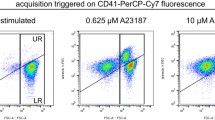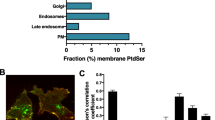Summary
The death of a cell results in a large amount of membrane lipid, predominantly phospholipids and cholesterol, that must be eliminated. In this study, we have examined what happens to phospholipids in dying rat platelets. Rat platelets were incubated for up to three days following their activation with thrombin. Platelet death occurred during the first day of incubation. This was indicated by a complete loss of platelet lactate dehydrogenase hydrogenase into the incubation medium. The platelets progressively lost over one-half of their phospholipid content during the three days of incubation. Cholesterol and sphingomyelin (the phospholipid with the highest affinity for cholesterol) were not lost during the same period. Our findings suggest that significant degradation of cellular non-sphingomyelin phospholipid can be triggered by cell death. The preservation of sphingomyelin in dying platelets, may be an adaptive response to maintain cholesterol in a solubilized state within dying cells.
Similar content being viewed by others
References
Bartlett GR (1959) Phosphorous assay in column chromatophy. J Biol Chem 234: 466–468
Bhuvaneswaran C, Venkatesan S, Mitropoulos KA (1985) Lysosomal accumulation of cholesterol and sphingomyelin: evidence for inhibition of acid sphingomyelinase. Eur J Cell Biol 37: 98–106
Bottcher CJF, Van Gent CM (1961) Changes in the composition of phospholipids and of phospholipid fatty acids associated with atherosclerosis in the human aortic wall. J Atheroscler Res 1: 36–46
Chien KR, Abrams J, Serroni A, Martin JT, Farber JL (1978) Accelerated phospholipid degradation and associated membrane dysfunction in irreversible, ischemic liver cell injury. J Biol Chem 253: 4809–4817
Chien NR, Pfau RG, Farber JL (1979) Ischemic myocardial cell injury. Prevention by chlorpromazine of an accelerated phospholipid degradation and associated membrane dysfunction. Amer J Pathol 97: 505–530
Chien NR, Reeves JP, Buja LM, Bonte F, Parkey RW, Willerson JT (1981) Phospholipid alterations in canine ischemic myocardium. Temporal and topographical correlations with Tc-99m-PPi accumulation and an in vitro sarcolemmal Ca2+ permeability defect. Circ Res 48: 711–719
Demel RA, Jansen JWCM, Van Dijck PWM, Van Deenen LLM (1977) The preferential interaction of cholesterol with different classes of phospholipids. Biochim Biophys Acta 465: 1–10
Ellis RE, Yuan J, Horvitz HR (1991) Mechanism and functions of cell death. Annu Rev Cell Biol 7: 663–698
Farber JL, Young EE (1981) Accelerated phospholipid degradation in anoxic rat hepatocytes. Arch Biochem Biophys 211: 312–320
Farber JL, Chien KR, Mittnacht S Jr (1981) The pathogenesis of irreversible cell injury in ischemia. Am J Pathol 102: 271–281
Fiske CH, SubbaRow Y (1925) The colorimetric determination of phosphorous. J Biol Chem 66: 375–400
Folch J, Lees M, Sloan-Stanley GH (1957) A simple method for the isolation and purification of total lipids from animal tissues. J Biol Chem 226: 497–509
Friedel R, Mattenheimer H (1970) Release of metabolic enzymes from platelets during blood clotting of man, dog, rabbit and rat. Clin Chim Acta 30: 37–46
Gamble W, Vaughan M, Kruth HS, Avigan J (1978) Procedure for determination of free and total cholesterol in micro-or nanogram amounts suitable for studies with cultured cells. J Lipid Res 19: 1068–1070
Kaduce TL, Norton KC, Spector AA (1983) A rapid, isocratic method for phospholipid separation by high-performance liquid chromatography. J Lipid Res 24: 1398–1403
Kruth HS, Blanchette-Mackie J, Avigan J, Gamble W, Vaughan M (1982) Subcellular localization and quantification of cholesterol in cultured human fibroblasts exposed to human low density lipoprotein. J Lipid Res 23: 1128–1135
Morris MD, Bhuvaneswaran C, Shio H, Fowler S (1982) Lysosome lipid storage disorder in NCTR-BALB/c mice. I. Description of the disease and genetics. Am J Pathol 108: 140–149
Nachas N, Pinson A (1992) Anoxic injury accelerates phosphatidylcholine degradation in cultured cardiac myocytes by phospholipase C, FEBS Lett 298: 301–305
Patton S (1970) Correlative relationship of cholesterol and sphingomyelin in cell membranes. J Theor Biol 29: 489–491
Reichl D, Miller NE (1986) The anatomy and physiology of reverse cholesterol transport. Clin Sci 70: 221–231
Rouser G, Solomon RD (1969) Changes in phospholipid composition of human aorta with age. Lipids 4: 232–234
Sandberg N, Andersson LO, Höglund S (1982) Isolation and characterization of lipid-protein particles containing platelet factor 3 released from human platelets. Biochem J 203: 303–311
Shirazi Y, Mergner WJ (1990) Phospholipids, phospholipases, and cell injury. In: Mergner WJ, Jones RT, Trump BF (eds) Cell death. Mechanisms of acute and lethal cell injury. Field and Wood, New York, pp 201–220
Skarlatos SI, Amende LM, Chao FF, Blanchette-Mackie EJ, Gamble W, Kruth HS (1988) Biochemical characterization of isolated cholesterol-phospholipid particles continuously released from rat and human platelets after activation. Lab Invest 59: 344–352
Shio H, Ramwell PW (1972) Prostaglandin E1 in platelet harvesting: an in vitro study. Science 175: 536–539
Smith EB (1974) The relationship between plasma and tissue lipids in human atherosclerosis. Adv Lipid Res 12: 1–49
Smith MW, Collan Y, Kahng MW, Trump BF (1980) Changes in mitochondrial lipids of rat kidney during ischemia. Biochem Biophys Acta 618: 192–199
Van der Vusse GJ, van Bilsen M, Reneman RS (1989) Is phospholipid degradation a critical event in ischemia-and reperfusioninduced damage? NIPS 4: 49–53
Venkatachalam MA, Patel YJ, Kreisberg JI, Weinberg JM (1988). Energy thresholds that determine membrane integrity and injury in a renal epithelial cell line (LLC-PK1). Relationships to phospholipid degradation and unesterified fatty acid accumulation. J Clin Invest 81: 745–758
Wattenberg BW, Silbert DF (1983) Sterol partitioning among intracellular membranes. Testing a model for cellular sterol distribution. J Biol Chem 258: 2284–2289
Author information
Authors and Affiliations
Rights and permissions
About this article
Cite this article
Skarlatos, S.I., Rao, R., Dickens, B.F. et al. Phospholipid loss in dying platelets. Virchows Archiv B Cell Pathol 64, 241–245 (1993). https://doi.org/10.1007/BF02915118
Received:
Accepted:
Issue Date:
DOI: https://doi.org/10.1007/BF02915118




